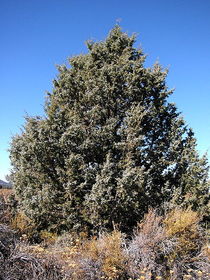
Picture of the has been licensed under a GFDL
Original source: Western Juniper Description: Western Juniper (Juniperus occidentalis) Viewpoint location: Lava Beds National Monument Road southwest of Lava Beds National Monument, location quality poor. GPS: UTM 10 630930E 4613758N (WGS84/NAD83) USGS CALDWELL BUTTE Quad [1] Viewpoint elevation: 4360' View direction: N/A Date and time: 2005.10.24 14:03:16 PDT Camera: Canon PowerShot S110 Photographer: Walter Siegmund ID assistance: MPF ©2005 Walter Siegmund
Permission: GNU Free Documentation License
Original source: Western Juniper Description: Western Juniper (Juniperus occidentalis) Viewpoint location: Lava Beds National Monument Road southwest of Lava Beds National Monument, location quality poor. GPS: UTM 10 630930E 4613758N (WGS84/NAD83) USGS CALDWELL BUTTE Quad [1] Viewpoint elevation: 4360' View direction: N/A Date and time: 2005.10.24 14:03:16 PDT Camera: Canon PowerShot S110 Photographer: Walter Siegmund ID assistance: MPF ©2005 Walter Siegmund
Permission: GNU Free Documentation License

Picture of the has been licensed under a Creative Commons Attribution-Noncommercial-Share Alike license.
Permission: Some rights reserved
Permission: Some rights reserved
Western juniper
The Juniperus occidentalis shoots are of moderate thickness among junipers, 1-1.6 mm diameter. The leaves are arranged in opposite decussate pairs or whorls of three; the adult leaves are scale-like, 1–2 mm long and 1-1.5 mm broad. The juvenile leaves are needle-like, 5–10 mm long. The cones are berry-like, 5–10 mm in diameter, blue-brown with a whitish waxy bloom, and contain one to three seeds; they are mature in about 18 months. The male cones are 2–4 mm long, and shed their pollen in early spring.Juniperus occidentalis (Western Juniper and Sierra Juniper) is a shrub or tree native to the western United States, growing in mountains at altitudes of 800-3,000 m (rarely down to 100 m). Foliage and cones Juniperus occidentalis var. australis, eastern Sierra Nevada, Rock Creek Canyon, California. Distinctive bark of Juniperus occidentalis var. australis, eastern Sierra Nevada, Rock Creek Canyon, California. The shoots are of moderate thickness among junipers, 1-1.6 mm diameter. More
Juniperus occidentalis, a gymnosperm, is a tree that is native to California and is also found outside of California, but is confined to western North America. More
